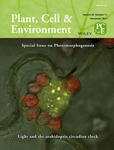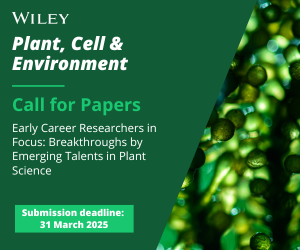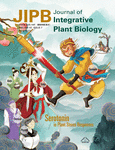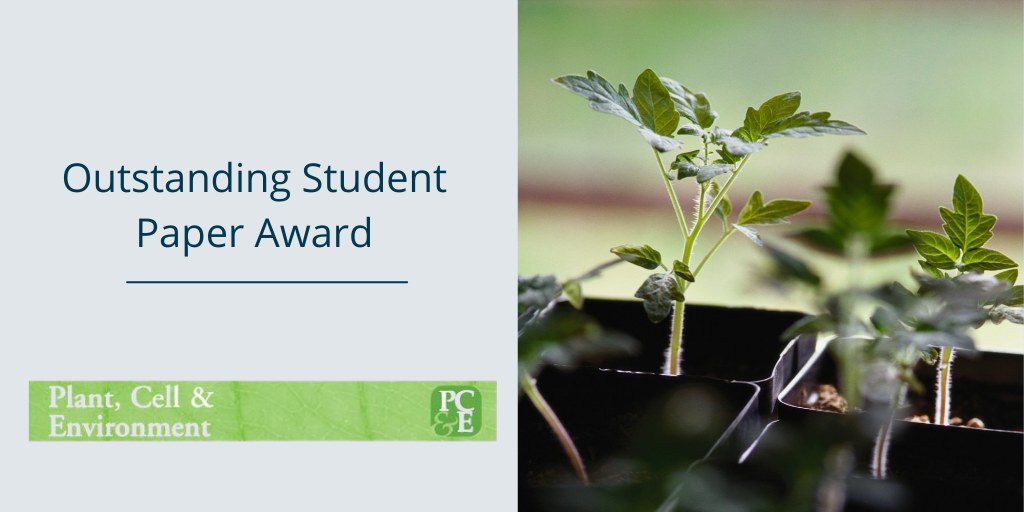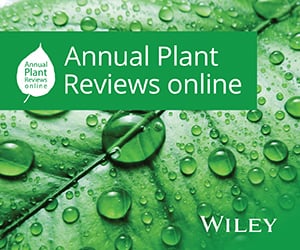Journal list menu
Export Citations
Download PDFs
REVIEWS
Ferns, mosses and liverworts as model systems for light-mediated chloroplast movements
- Pages: 2447-2456
- First Published: 17 November 2016
Molecular mechanisms of chloroplast photorelocation movement are partially elucidated from the molecular genetic research using Arabidopsis thaliana. However, researches using fern, moss and liverwort not only complement the results by Arabidopsis researches but also provide new insights that never are given by Arabidopsis research.
New insights of red light-induced development
- Pages: 2457-2468
- First Published: 09 December 2016
Phytochromes sense changes in the ratio and intensity of red and far-red content of sunlight and by initiating/controlling a complex signalling network regulate nearly all aspect of plant growth and development. Recent research revealed exciting new aspects at molecular level how these photoreceptors function, uncovered the basic difference in the mode of action for the two major phytochrome species, phyA and phyB, and demonstrated that phyB also functions as a thermosensor. This review summarizes and discusses the most important discoveries that opened new avenues for phyB-related research.
Development of transgenic crops based on photo-biotechnology
- Pages: 2469-2486
- First Published: 23 December 2016
Dancing in the dark: darkness as a signal in plants
- Pages: 2487-2501
- First Published: 03 January 2017
Daily cycles of light and darkness provide structure that plants use to temporally organize aspects of their physiology and growth. Plants use distinct modes of growth in continuous dark versus light–dark cycles but these programmes share many components. In this review, we examine progress toward understanding how plants coordinate light-sensitive and time-sensitive processes to optimize growth and resource allocation across the day–night cycle, and how darkness changes the function of gene regulatory networks involved in seedling growth, timing and metabolism.
Evolutionary origin of phytochrome responses and signaling in land plants
- Pages: 2502-2508
- First Published: 18 January 2017
Phytochrome photoreceptors that regulate many aspects of growth and development throughout the plant life cycle originated in the common ancestor of streptophytes and diversified during the course of land plant evolution. Recent advances in molecular genetics using the moss Physcomitrella patens and the liverwort Marchantia polymorpha revealed that basal land plants show FR-induced responses and that the establishment of phytochrome-mediated transcriptional regulation dates back to at least the common ancestor of land plants. In this review, we summarize our knowledge concerning functions of land plant phytochromes, especially in basal land plants, and discuss subfunctionalization/neofunctionalization of phytochrome genes in the lineages of land plants.
Molecular mechanisms and ecological function of far-red light signalling
- Pages: 2509-2529
- First Published: 19 January 2017
Far-red light regulates several responses in plants, including seed germination, suppression of hypocotyl growth, induction of flowering and accumulation of anthocyanins. Here, we review the current understanding of how plants sense far-red light through phytochrome A and how downstream signalling works at the molecular level.
The shade-avoidance syndrome: multiple signals and ecological consequences
- Pages: 2530-2543
- First Published: 19 January 2017
During the last four decades, there has been an enormous increase in our understanding of how plants sense shading and the proximity of neighbours and how they activate adaptive morphological and physiological responses. Important elements of the signal transduction pathways that connect informational photoreceptors with functional responses have been elucidated, and shade avoidance has become a textbook example of adaptive plasticity. It is now becoming clear that proximity perception leads to a complete reconfiguration of plant function. This reconfiguration allows the plant to optimize the deployment of leaves into light gaps, balance resource allocation between shoots and roots, optimize leaf gas exchange and nutrient uptake as a function of the degree of shading and adaptively regulate interactions with herbivores, pathogens and beneficial microorganisms. In this review, we describe the progress in understanding shade-avoidance mechanisms and highlight the diversity of plant processes and functions that are controlled by canopy light signals.
Photomorphogenic responses to ultraviolet-B light
- Pages: 2544-2557
- First Published: 09 February 2017
Exposure to UV-B light regulates plant metabolism, morphology and physiology through differential gene expression. This review summarizes current understanding of the role of the photoreceptor UVR8 in mediating photomorphogenic responses to UV-B, including its interactions with other signaling pathways and its action under natural growth conditions.
Algal light sensing and photoacclimation in aquatic environments
- Pages: 2558-2570
- First Published: 28 February 2017
Aquatic environments pose daunting challenges for efficient light harvesting and photosynthesis, requiring novel photoacclimation strategies in eukaryotic algae. Recent studies provide new insight into the loss and repurposing of bilin-based photoreceptors in algae that facilitate responses to inevitable changes in light fluences inherent to their complex light environments.
Shining a light on the Arabidopsis circadian clock
- Pages: 2571-2585
- First Published: 21 July 2017
Light perception establishes the major time-setting mechanism within the Arabidopsis circadian clock, with each wavelength of light leading to respective input pathways. Convergence exists between these pathways to form regulatory feedback loops, as light perception itself is circadian controlled. The signalling mechanisms between specific photoreceptors and their subsequent interactors, leading to clock setting, are largely unknown and is therefore an interesting area for further investigation.
Redox regulation at the site of primary growth: auxin, cytokinin and ROS crosstalk
- Pages: 2586-2605
- First Published: 14 July 2017
Changing climate affects agriculture and plant biodiversity around the globe. Given that the recovery of the plants after abiotic stress periods requires apical meristems survival, a more thorough understanding of plant meristem functioning and maintenance is crucial. Therefore, in this review, we provide an overview of how reactive oxygen species (ROS) and the main developmental hormones auxin and cytokinin are interconnected through redox systems to balance maintenance of meristematic zones upon stress. We also emphasize the need to interpret hormonal and ROS networks as interconnected mechanisms rather than as independent pathways.
COMMENTARY
A dichotomy resolved: Plant growth can control the rate of starch accumulation
- Pages: 2606-2607
- First Published: 30 August 2017
ORIGINAL ARTICLES
Photosynthate partitioning to starch in Arabidopsis thaliana is insensitive to light intensity but sensitive to photoperiod due to a restriction on growth in the light in short photoperiods
- Pages: 2608-2627
- First Published: 19 June 2017
Plants accumulate starch in the light period to provide carbon reserves to support metabolism, maintenance and growth during the night. We grew plants at three different irradiances in 6 h and a 12 h photoperiod to investigate whether lower carbon gain during the day leads to increased starch accumulation. The proportion of photosynthate allocated to starch was only slightly higher in low irradiance, but was much higher in short photoperiods. This increase in allocation to starch was due to a specific restriction of the use of carbon for growth in the light in short photoperiods.
Barley transcriptome analyses upon interaction with different aphid species identify thionins contributing to resistance
- Pages: 2628-2643
- First Published: 27 April 2017
Non-host and poor-host resistance to aphids is poorly understood and is key for development of novel crop resistances to insect pests. Here, we used barley as a monocot model crop plant to study the interaction with aphid species that differ in their ability to infest and analysed barley transcriptional responses during interactions. Our work provides insights into how barley responds to different types of aphid interactions. Importantly, we identified barley genes contributing to plant defences against aphids.
The dual role of LESION SIMULATING DISEASE 1 as a condition-dependent scaffold protein and transcription regulator
- Pages: 2644-2662
- First Published: 27 May 2017
LESION SIMULATING DISEASE 1 (LSD1) is an important regulator of both biotic and abiotic stress responses as well as plant fitness. However, to date, its molecular mode of action remained enigmatic. This study is the first such comprehensive report on LSD1 molecular and cellular function. We demonstrate that LSD1 constitutes a condition-dependent molecular regulator of diverse cellular processes by acting as a redox-sensing scaffold protein and transcription regulator.
Solanum dulcamara's response to eggs of an insect herbivore comprises ovicidal hydrogen peroxide production
- Pages: 2663-2677
- First Published: 01 July 2017
While plant defences to tissue feeding life stages of insect herbivores are well investigated, much less is known on plant defence responses to insect oviposition. This study unveils a simple and effective plant defence mechanism against insect eggs that is based on ovicidal hydrogen peroxide production. Until now, the role of such reactive oxygen species during plant responses to insects is merely viewed in their function as signalling components. Yet, Solanum dulcamara's ovicidal hydrogen peroxide production suggests broader functions for the release of reactive oxygen species in ecological interactions.
The identification of new candidate genes Triticum aestivum FLOWERING LOCUS T3-B1 (TaFT3-B1) and TARGET OF EAT1 (TaTOE1-B1) controlling the short-day photoperiod response in bread wheat
- Pages: 2678-2690
- First Published: 01 July 2017
We identify two novel short photoperiod wheat flowering time genes TaFT3-B1 and TaTOE1-B1 that promote and repress flowering, respectively. We show that TaFT3-B1, the homologue of Ppd-H2 in barley, and TaTOE-B1 (less studies in the cereals) are likely candidates for the short-day-specific QTL that we report upon. The TaTOE1-B1 homologue in Arabidopsis thaliana is involved in the ageing pathway, suggesting that wheat and possibly other cereals use the same pathway. The four alleles of TaFT3-B1 and three alleles of TaTOE1-B1 we identified for these genes present alternative routes for the fine tuning of flowering time control in wheat.
Airborne signals from Trichoderma fungi stimulate iron uptake responses in roots resulting in priming of jasmonic acid-dependent defences in shoots of Arabidopsis thaliana and Solanum lycopersicum
- Pages: 2691-2705
- First Published: 01 July 2017
Our study describes a set of novel discoveries about the role of airborne signals from plant-beneficial fungi in the elicitation of iron uptake mechanisms and induced systemic resistance (ISR) in Arabidopsis and tomato plants. We demonstrate that airborne signals produced by two resistance-inducing Trichoderma species activate locally the iron acquisition machinery in the roots of both Arabidopsis and tomato and that the activation of this process is associated with systemic priming of foliar tissues for enhanced jasmonic acid-dependent defences and ISR. Moreover, using micrografting, we show for the first time that the microbial volatiles are perceived by the roots (not the leaves) and that this is associated with systemic priming of the leaves for jasmonic acid-dependent defences and ISR against necrotrophic fungi (in both Arabidopsis and tomato).
Medicago truncatula Zinc-Iron Permease6 provides zinc to rhizobia-infected nodule cells
- Pages: 2706-2719
- First Published: 21 July 2017
Symbiotic nitrogen fixation carried out in legume nodules requires relatively large levels of essential transition metals. These nutrients have to be provided by the host plant through dedicated metal transporters. Here, we have determined the role of MtZIP6 in providing zinc to rhizobia-infected cells in Medicago truncatula nodules and shown that efficient zinc supply is required for nodule nitrogenase activity.
CATALASE2 functions for seedling postgerminative growth by scavenging H2O2 and stimulating ACX2/3 activity in Arabidopsis
- Pages: 2720-2728
- First Published: 19 July 2017
Fatty acid β-oxidation is essential for early postgerminative growth in seedlings, but high levels of H2O2 produced by β-oxidation can induce oxidative stress. Whether and how catalase (CAT) functions in fine-tuning H2O2 homeostasis during seedling growth remain unclear. By using sucrose-free 1/2 MS medium mimicking soils without exogenous sugars supply, our study showed that CAT2 plays an important role in early seedling growth by scavenging H2O2 and stimulating acyl-CoA oxidase activity.
Components of mesophyll resistance and their environmental responses: A theoretical modelling analysis
- Pages: 2729-2742
- First Published: 25 July 2017
Mesophyll resistance, stomatal resistance, and biochemical limitations are three critical factors limiting leaf photosynthesis. Here, we present an analytical model of mesophyll resistance and its components, which incorporates various anatomical and biochemical factors including permeabilities of cell wall and chloroplast envelope to CO2 and HCO3−, carbonic anhydrase activities in cytosol and stroma, Rubisco activities, and relative location of mitochondria and chloroplast. This analytical model is validated against 3-dimensional reaction–diffusion models for both a mesophyll cell and a leaf. The new analytical model and the 3-dimensional models form a theoretical framework to study the mechanism of mesophyll resistance and its components and their environmental responses.
Vernal freeze damage and genetic variation alter tree growth, chemistry, and insect interactions
- Pages: 2743-2753
- First Published: 29 July 2017
Vernal freezes are likely to become more frequent with climate change, yet the effects of freeze events on plants and their interactions with insects have received little attention. This paper examines how the interplay of vernal freeze damage and genetic variation in a hardwood tree species influences growth, phytochemistry, and interactions with an insect herbivore. Acute freeze damage dramatically increased sapling mortality, and surviving trees exhibited reduced growth, altered biomass distribution, altered phytochemistry, and supported 2× faster aphid population growth. Our study demonstrates that a single damaging vernal freeze event can alter tree–insect interactions in a dominant forest species through effects on plant growth and chemistry, and that genotypic differences in tree responses to freeze damage may alter the genetic structure of tree populations.
F-group bZIPs in barley—a role in Zn deficiency
- Pages: 2754-2770
- First Published: 01 August 2017
The heavy metal micronutrient Zinc (Zn) is crucial for all organisms, and therefore, crops grown in soils with low Zn availability yield less and have a reduced nutritional quality. Developing cereals that can maintain growth and yield on low Zn soils without the input of costly fertilizers, and accumulate more Zn in the edible parts, would have clear benefits for sustainable agriculture. F-group bZIP transcription factors, AtbZIP19 and AtbZIP23, regulate the Zn-deficiency response in Arabidopsis by upregulating a range of genes involved in Zn uptake and partitioning. Our molecular and genetic results suggest that the mechanisms that allow barley, an economically important cereal, to adapt to low Zn conditions are conserved. We show that there is an expanded number of F-group bZIPs in barley (seven) and, from functional complementation and gene expression studies, provide evidence supporting a role for HvbZIP56 and HvbZIP62 in adapting to low Zn conditions.
Stomatal heterogeneity in responses to humidity and temperature: Testing a mechanistic model
- Pages: 2771-2779
- First Published: 04 August 2017
This work quantifies the variation in stomatal conductance over the surface of a leaf as stomata respond to humidity and temperature. The data are used to test a recently proposed mechanism for stomatal responses to humidity and temperature.
Cucurbit extrafascicular phloem has strong negative impacts on aphids and is not a preferred feeding site
- Pages: 2780-2789
- First Published: 04 August 2017
Unlike the sugar-rich fascicular phloem of cucurbits, the atypical extrafascicular phloem is low in sugars and its function has remained unclear. Here, we used aphids as a major group of phloem feeders to demonstrate quantitatively that extrafascicular phloem is avoided by aphids and it strongly impairs their performance. On this basis, we propose that extrafascicular phloem may be less involved in nutrient distribution but instead may potentially act in herbivore resistance.
Environmental plasticity of Pinot noir grapevine leaves: A trans-European study of morphological and biochemical changes along a 1,500-km latitudinal climatic gradient
- Pages: 2790-2805
- First Published: 09 August 2017
In this paper, morphological and biochemical parameters (flavonoid and carotenoid composition, non-enzymatic leaf total antioxidant capacity and ultraviolet (UV)-absorbing pigment content) of Pinot noir grapevine leaves were measured at different vineyards across a 1,500-km latitude gradient in Europe.
We identified cumulative UV radiation as the strongest correlator with most leaf metabolites and pigments and also found that leaf fresh weight and area were negatively correlated with both global and UV radiation.
The acquired data set also allowed the analysis of complex interactions between various classes of metabolites in responding to environmental conditions. The study emphasizes the physiological component of plant responses to latitudinal gradients and reveals the physiological plasticity that may act to complement genetic adaptations.
Overexpression of DEMETER, a DNA demethylase, promotes early apical bud maturation in poplar
- Pages: 2806-2819
- First Published: 15 August 2017
Winter dormancy is a pivotal developmental and physiological process for the survival of the main terrestrial carbon sink: temperate and boreal forests. These works reveal the crosstalk between the environmentally-controlled active DNA demethylation and bud maturation in poplar. Indeed, the evidences presented here provide direction for future studies designed to address regulation of shoot growth in response to the environment.
Direct uptake of HCO3− in the marine angiosperm Posidonia oceanica (L.) Delile driven by a plasma membrane H+ economy
- Pages: 2820-2830
- First Published: 16 August 2017
In this work, we have investigated the effect that the enrichment of HCO3− has on the cytosolic homeostasis of H+, Na+, and Cl− in the marine angiosperm Posidonia oceanica, to identify the inorganic carbon species that crosses the plasma membrane and the driving ion that fuels such transport. The enrichment of natural seawater with HCO3− evokes a transient acidification of cytosolic pH followed by an alkalinization that lasts as long as the HCO3− pulse lasts. This result, along with the sensitivity of the cytosolic alkalinization to ethoxyzolamide, suggests the operation of an H+/HCO3− symport and an internal dehydration of this ion. Na+ and Cl− do not have an effect on the transport. A kinetic and energetic characterization for the HCO3− transport and its effect on a putative carbon concentration mechanism is also discussed. To our knowledge, this is the first direct evidence for an active HCO3− transport in plants, and it can be a relevant part of the strategy of inorganic carbon use in seagrasses.
The Arabidopsis U-box E3 ubiquitin ligase PUB30 negatively regulates salt tolerance by facilitating BRI1 kinase inhibitor 1 (BKI1) degradation
- Pages: 2831-2843
- First Published: 02 September 2017
- The Arabidospsis U-box E3 ubiquitin ligase, PUB30, specifically interacts with a brassinosteroids dual regulator, BRI1 kinase inhibitor 1 (BKI1).
- PUB30 regulates the degradation of BKI1.
- The bki1 mutant and the transgenic plants overexpressing BKI1 displayed salt-sensitive and tolerant phenotype during seed germination, respectively.
- PUB30 negatively regulates salt tolerance probably by mediating the degradation of BKI1 and functions through brassinosteroids signaling.
Cold sensing in grapevine—Which signals are upstream of the microtubular “thermometer”
- Pages: 2844-2857
- First Published: 12 September 2017
Cold stress limits the agricultural use of many plants in temperate climate, including the cash crop grapevine. One of the early responses to cold stress is the elimination of microtubules. This microtubule response has been shown to be required to activate efficient adaptation to cold. In the current work, we dissect the early events of cold signalling upstream of microtubules using a transgenic grapevine cell line expressing a fluorescent tubulin marker. We find that calcium influx, membrane rigidification, and activation of NAD(P)H oxidase contribute to signalling, and that a G protein in concert with phospholipase D convey the signal towards microtubules, whereas calmodulin seems to be not involved. Moreover, cold-induced activation of the jasmonate pathway is required for an efficient microtubule response. We summarize our findings in a working model on a complex signalling hub at the membrane-cytoskeleton interphase that assembles the susception, perception, and early transduction of cold signals. These insights can be used in the future to design strategies targeted on improved cold tolerance, either by molecular-assisted breeding, or, alternatively to genetic changes, by chemical manipulation of early signalling events in order to improve cold tolerance of cultivars which are otherwise cold-sensitive in temperate climates.
OPINION
Are plants sentient?
- Pages: 2858-2869
- First Published: 06 September 2017
The phloem is the pathway for plant electrical communication. In this opinion article, we report that this system is cross-linked, is thus nervous-like, and explore several potential properties. Prioritisation between different signals may be one of this system's emergent capabilities. Animals prioritise their signal responses using sentience. We suggest some future investigations to clarify functioning and the potential involvement of bioelectric fields in both learning and memory.
TECHNICAL REPORT
A practical approach to estimate diffusional leakages of leaf chamber of open gas exchange systems using intact leaves
- Pages: 2870-2874
- First Published: 06 October 2017
The aim of this study is to estimate the coefficient of CO2 diffusional leakage (k_CO2) in the chamber of gas exchange system using intact leaves. Assuming that dark respiration rate is constant irrespective of CO2 concentrations in the chamber, we can estimate k_CO2 as the value minimizing the variance in the leak-corrected dark respiration rates. We believe that this practical approach using intact leaves would provide a feasible way to correct net photosynthetic rates taking diffusional leakage into account.




